Gentle Leader vs. prong collar (pinch collar)
That Mutt is supportive of a variety of dog training methods. This is not about “one vs. the other” but instead focuses on some of the pros & cons of different types of collars.
There is no dog training collar that is right for every dog.
I have recommended every type of dog training collar to someone at some point. Every dog is different, and every owner is different. What works for my dog is not necessarily going to work for your dog.
I don’t admire dog trainers who try to push a single tool on everyone.
Every type of dog training collar has its place for the right dog in the right situation. This does not mean it’s right for YOUR dog or my dog.
This post may contain affiliate links. That Mutt may earn money from the companies mentioned in this post.
Some of those tools to stop a dog’s pulling include:
Most dogs are going to respond well to a strong, fun leader who uses positive reinforcement along with mild “corrections.”
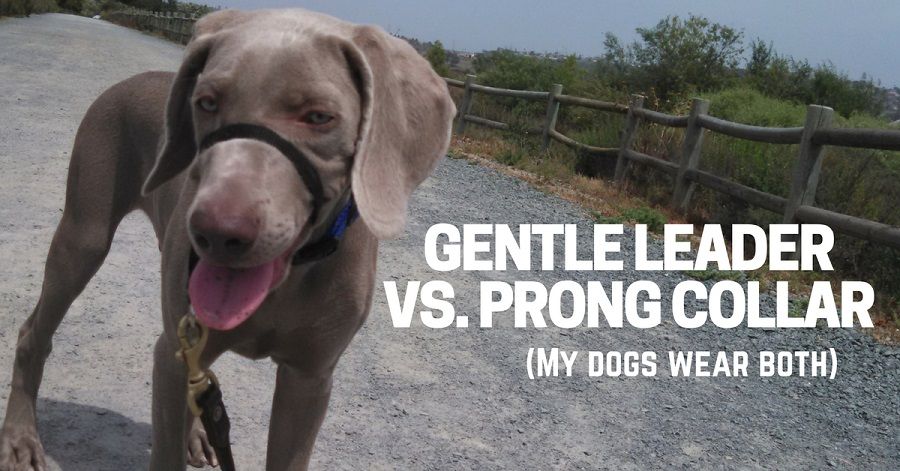
The two collars I want to focus on for this post are the Gentle Leader and the pinch (prong) collar. They are very different tools but are some of the most common tools recommend for strong pullers.
Remember that both tools are just that – training tools. They will not magically stop most dogs from pulling. We still have to put in the work.
*Enjoying this article? Get realistic dog training tips emailed once a week. Click Here
Gentle Leader vs. pinch collar
The Gentle Leader is marketed as a gentle option to be worn over a dog’s muzzle, similar to a horse halter.
The Gentle Leader is designed to prevent pulling because if the dog handler controls the dog’s head, he controls the dog.
A pinch (prong) collar is usually made out of metal and has flat prongs distributed evenly around the collar. It should be worn high on the dog’s neck, right under his chin, and behind his ears.
When the dog pulls, the owner can give a slight “correction” by pulling up or to the side. This correction is not designed to cause pain. It is intended to redirect a dog’s attention.
Let me explain what I like and don’t like about each of these collars. I hope to disprove some of the assumptions about each.
In a lot of ways, these tools work very much the same even though they look drastically different. Both the Gentle Leader and the prong collar make pulling slightly uncomfortable for the dog in order to encourage him to stop pulling.
Gentle Leader for dog training
When I was teaching my mutt Ace to walk nicely on a leash, I used the Gentle Leader in some situations and a pinch collar in others.
With my current dog, a Weimaraner named Remy, I am once again using both tools.
What I like about the Gentle Leader
Reason #1: The Gentle Leader helps some dogs remain calm
I use a Gentle Leader when I want to help the dog calm down. It’s a good tool to use when I want to bring my dog along but might be preoccupied.
However, most dogs do freak out a bit when they first have something over their muzzle area. So it’s important to slowly desensitize your dog to wearing a Gentle Leader using treats. Don’t just slap it on and head out for a walk or he will probably paw at it the whole time, trying to get it off.
By slowly introducing the Gentle Leader over several days, you will help your dog see it as a positive experience.
So, back to being calm …
Once the dog is used to the Gentle Leader, the tool allows me to relax and just enjoy spending time with my dog in busy situations.
For example, if I’m walking my dog downtown while talking with a friend and holding a coffee in one hand, the Gentle Leader comes in handy. It allows me to “check out” a bit from dog training.
My dog Ace was anxious in the car, and the Gentle Leader worked to help him chill out a bit. The fabric around his muzzle calmed him and put him in a less excited state of mind.
As another example, my foster dog was feeling stressed out at an adoption event we attended. He was barking at me and having difficulty settling down. When I put his Gentle Leader on him, he was able to lie down next to me and relax.
Reason #2: The Gentle Leader stops a dog from making those “choking” sounds
The Gentle Leader is also a good tool to keep my dog from pulling and making those “choking” noises.
Remy is a good example of a dog who practically strangles himself on a regular, nylon collar. He gets so excited, panting, pulling, and “choking” that he causes other dogs to get very agitated as well.
When Remy wears a Gentle Leader, it eliminates his panting and choking noises by about 90 percent. When he’s quiet, other dogs are less likely to react.
Since Remy is still learning how to ignore other dogs during walks, anything that helps him give off calmer energy is a good thing.
If Remy is calm and quiet on walks, then walks are much, much more enjoyable! That means he gets to go along on more walks!
*Enjoying this article? Get realistic dog training tips emailed once a week. Click Here
What I don’t like about the Gentle Leader
Reason #1: The Gentle Leader can put pressure on a dog’s nose and eyes
Any collar can be dangerous if the dog pulls for an extended period of time.
The Gentle Leader is not always a safe tool for extreme pullers.
Are Gentle Leaders cruel?
No, they are not cruel. The Gentle Leader is marketed as a humane option, and for the most part, this is true.
However, when a dog pulls very hard for an extended period of time, the thin piece of nylon over his nose begins to put way too much pressure on the dog’s face and under his eyes.
Dogs that are so focused on moving forward do not have enough sense to stop pulling, even if they are in pain. The pain might even cause them to pull harder, as they are trying to escape the pain.
Excited dogs do not always know how to calm down and rationalize what is happening.
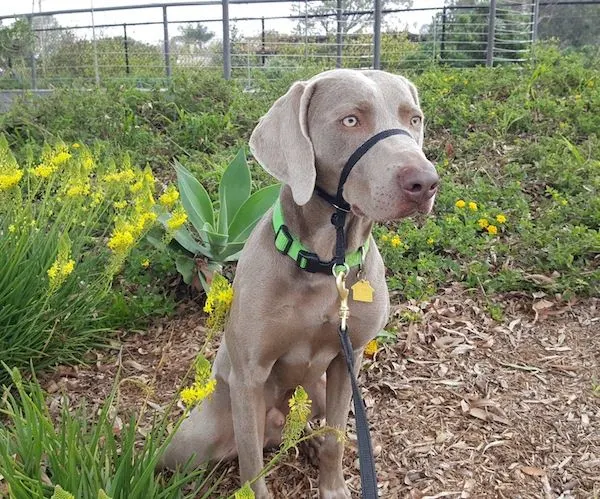
Example with my foster dog wearing the Gentle Leader
For example, one time I took foster dog Cosmo for a longer walk than usual. He wore his Gentle Leader. When we came back, he was squinting his eyes for the rest of the night because of the pressure the Gentle Leader had caused.
I was really worried I had permanently damaged his eyes! I was mad at myself for not stopping during the walk and switching to his regular collar.
Thankfully, bug-eyed Cosmo was just fine the next morning. Still, the incident was enough for me to re-think the Gentle Leader. Now I rotate which collar I use when I’m walking certain dogs.
For shorter walks, a Gentle Leader might be fine. For longer walks, the pinch collar might be better.
And just for the record, the Halti Head Collar is a similar tool to the Gentle Leader, but it’s designed better and typically doesn’t put too much pressure on a dog’s nose or eyes.
It also has a safety strap that connects to the dog’s normal collar just in case he slips out of the Halti. For more info, check out my post comparing the Halti vs. Gentle Leader.
Reason #2: The Gentle Leader does not teach a dog to stop pulling
For many dogs, the Gentle Leader is a “Band-Aid” if you are not actively working to actually train your dog.
By that, I mean a lot of dogs learn not to pull as long as they are wearing the Gentle Leader. As soon as you remove it, they go right back to pulling.
This is not the end of the world as long as you are OK using the Gentle Leader whenever you don’t want your dog to pull. If you want to eventually wean your dog off the Gentle Leader, then try to actively work on “heel” or loose-leash walking.
This is one reason why I use the Gentle Leader in some situations and the prong collar in other situations.
My goal is always to get to the point where no training collar is needed at all, and I find it easier to transition from the prong collar to a regular collar since both fit around the dog’s neck.
Reason #3: Some dogs hate wearing a Gentle Leader
Most dogs do not have any issues with a pinch collar because they’re used to having a collar around their neck.. But a lot of dogs do not like having something over their nose/face area.
My mutt Ace pretty much shut down at the sight of his Gentle Leader. His tail went between his legs, and he looked away. Once he had the Gentle Leader on and we went for a walk, he was fine, but he still avoided me every time I got it out.
My dog Remy also runs the other way when he sees me grab the Gentle Leader. But if I get the prong collar out, he gets excited and comes running!
Like I said earlier, some dogs really put up a protest, pawing at their nose and rubbing their face on the ground in an attempt to get the Gentle Leader off.
This is why it’s important to slowly desensitize your dog to wearing this tool using treats.
Reason #4: You can’t give a dog a leash correction while she’s wearing a Gentle Leader
There are situations where I prefer to give a dog a mild leash “correction” (tug on the lash) for training purposes.
The Gentle Leader is not designed for corrections. In fact, you could potentially hurt their neck by tugging on the Gentle Leader, although this is unlikely.
Pinch collar for dog training (also called a prong collar)
What I like about the Herm Sprenger prong collar
I recommend the Herm Sprenger brand of prong collar as it’s the best quality.
Reason #1: The prong collar allows you to give the dog a gentle correction
If my dog is focused on a smell or another dog during a walk, all he needs is gentle tug on the leash and prong collar to re-direct his attention.
This is not meant to scare him or cause pain. It’s just a reminder to get him to focus on the task at hand – walking. Sort of like a tap on the shoulder, like, “Hi, remember me?”
Usually my dog’s response to one of these tugs looks something like, “Ha, sorry. I got distracted!”
I tug on his leash so gently that I believe it is actually the slight sound of the chain moving that gets his attention, not the sensation of the prongs on his neck. Remember, these prong are FLAT.
Reason #2: The prong collar will help teach a dog not to pull
The pinch collar fits around a dog’s neck like a normal, nylon collar. This makes it easy to eventually transition the dog from the pinch collar to a nylon collar.
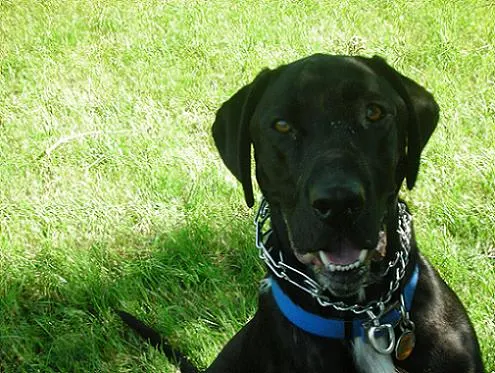
When I was teaching Ace to heel, I would have him wear his nylon collar and his prong collar at the same time. That way I could switch his leash to one collar or the other as appropriate.
For example, if Ace was walking nicely, I’d clip his leash to his nylon collar. If we saw another dog approaching, I would clip his leash to the pinch collar.
What I don’t like about the pinch collar
Reason #1: The links on the pinch collar could break apart
I’ve seen a few pinch collars come apart because one of the prongs was bent. This should not happen if you buy a high-quality Herm Sprenger prong collar.
I had a cheaper brand for a few years and ours did break apart on a walk once or twice. Luckily, Ace had no interest in running away. When his pinch collar fell off, he just stood there looking at me. “Well, aren’t you gonna pick that up?”
Reason #2: The pinch collar gets caught in long hair
I didn’t like the prong collar for my foster dog was because it didn’t seem to work with his thick fur. He was an American Eskimo dog.
It works better on my dog Remy the weimaraner, who has very short fur. I’d like to hear some other opinions on this.
Reason #3: The pinch collar can hurt a dog if it is not used properly
Is a prong collar cruel?
The prong collar is absolutely not cruel. It is a humane training tool.
However, I don’t use a pinch collar on a dog unless I am calm. If I am frustrated with a dog, I might be too tempted to give the dog a harsher tug on the leash. This is not what the pinch collar is for.
I also see too many dog owners who do not use the pinch collar as a training tool. They just place it around the lower part of a dog’s neck and hope for the best.
But the pinch collar is designed to be worn high on the dog’s neck, right behind her ears and under her chin. If the pinch collar is worn on the thickest part of the dog’s neck, it will be too easy for her to pull.
The pinch collar should be used as a tool to prevent pulling, not to just make the pulling more tolerable for the person.
Reason #4: Sensitive dogs might overreact to a pinch collar
Cosmo yelped the first couple of times I corrected him with the pinch collar even though I was careful not to be harsh. He was so sensitive that any correction at all scared him.
He also reacted aggressively a few times by biting the leash. This is why some people say a prong collar can make a dog’s aggression worse.
This is not the case with most stable dogs but can trigger a reaction from sensitive dogs like Cosmo. He would sometimes react on his regular nylon collar as well. I believe his “temper tantrums” were due to a low-frustration tolerance.
I’ve seen this occasionally with my dog Remy as well. He has reacted a few times to other dogs while wearing the prong collar but not while wearing the Gentle Leader.
What training collar is best for extreme pullers? Gentle Leader vs. prong collar
Obviously there are dozens of different dog training collars. I only focused on two in this post. I’d love to hear your opinion on the option that works better for your dog – the Gentle Leader or the pinch collar or a different tool entirely.
Which dog training collar is best for your dog?
Let me know what you think of the Gentle Leader vs. prong collar.
*Enjoying this article? Get realistic dog training tips emailed once a week. Click Here
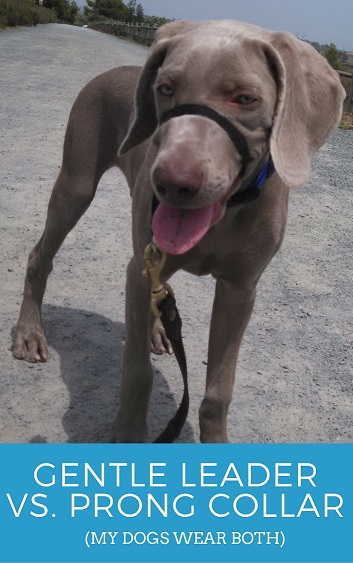
TRAINING TOOLS MENTIONED IN THIS POST:
- Gentle Leader.
A Gentle Leader fits around the dog’s muzzle for a gentle way to encourage the dog not to pull. - Prong collar.
Prong collars are helpful training tools for strong pullers that makes it easier to transition to a regular, flat collar. - No-pull harness.
An EasyWalk no-pull harness is helpful if you prefer a harness for training. The leash clips to the chest, encouraging the dog not to pull.
Related articles:
- How to stop a dog from pulling
- Gentle Leader vs. Halti
- No-pull harness vs. Gentle Leader
- Which collar is best for extreme pullers?
- Does a no pull harness really work?
- E-collar training
Lindsay Stordahl is the founder of That Mutt. She writes about dog training, dog exercise and feeding a healthy raw diet.


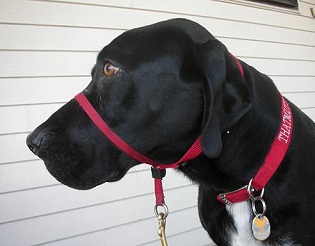

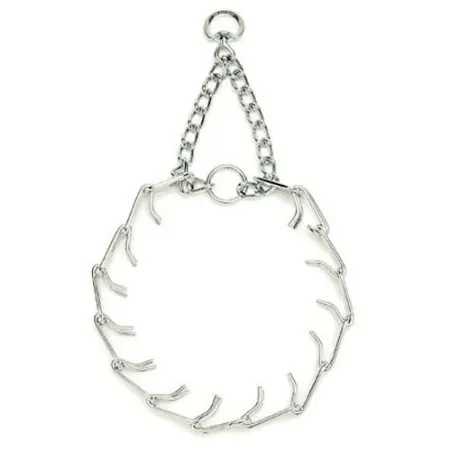
Mandy-Foster Bully breed mix
Wednesday 18th of October 2023
Although this article was written yeara ago, it is what I needed to read today! Thanks for writing it! I have a foster who I have been debating using a Herm Springer prong. Many places I read as doing research talk of how detrimental it can be. You talk of if it doesn't work just switch to gentle leader. Dog won't be completely traumatized after few times while figuring it out. She has some medical testing this week. After figure that out definitely going to get both and see what she responds best to. She is one that still is nervous on leash at times. But when she sees a dog, game on (lots of frustration). I have done lots of training with her, but looking for something to get attention when I don't see that dog coming or the scary persok coming. Which is the whole leash as she lives with s dog and plays with the neighbors dog and other dogs off leash. She is a Bully breed of some sort (some say bulldog due to body structure, others cane corso due to her face and jaw line, and others pitty due to size) that looks like a Boston from certain angles. Thanks again for the article. I am excited to try some new things with confidence I won't break her!
Leisa
Monday 3rd of April 2023
I will note that the Herm Sprenger can come apart. It is possible if the prongs are not well seated. So it is not a quality issue, but rather endemic to the type of linkage. Always tie in to your dog's collar in such cases. (Comment comes from a "ask me how I know situation"). I've used this collar to successful train a couple of my bully breeds. They both enjoyed the collar (yes, enjoyed), responded well with it, and did fine being weaned off of it. I have used the gentle leader, but I was not satisfied with the fit proximate to my dog's eyes--and they did not much like it either. Different tools for different problems. Best to have a quiver of solutions, and you noted that quite well.
Michael Daniel
Monday 27th of February 2023
I’m a firm believer in the prong collar now after using the old choker style collar for years. The reason being was a study was done on dogs (after they had passed, of course) that were subjected to the chokers all had tracheotomy damage. I switched immediately and have never looked back. When used and put on PROPERLY my thumb and index finger holding the leash is all that is required to maintain control of even very large dogs. One thing I would add to this article. When using a prong collar during training ALWAYS have a second collar loosely on the dog in cases the prong collar does break.
Patty
Thursday 6th of October 2022
The newest research shows the prong collar is an adversive training aid. Please love your dogs enough to find alternate training devices. Thank you, Patty
Renee Halm
Tuesday 11th of January 2022
Years ago, while taking a group dog training class, our intructor placed a prong collar on each of our arms and gave a gentle pull it prove to us that it didn't hurt. I was sold. I have since used prong collars to train several dogs. They are like power steering for large dogs! My dogs get excited as soon as they see me take it out, and sit to let me slip it over their head. Eventually I transition them to their usual buckle collar, but sometimes I start a walk with the prong collar and switch the leash over to the buckle collar after the initial excitement over going for a walk is over. Try to find the kind where you don't have to take the links apart to put it on and take it off. MUCH easier!
Renee Halm
Tuesday 11th of January 2022
@Renee Halm, Oh, these digs were all Irish Setters and I never had a problem with the prongs getting tangled in their fur.